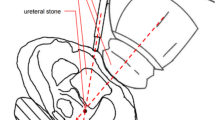Abstract
Objectives: To evaluate the factors that affect the success rate of extracorporeal shock wave lithotripsy (ESWL) for treatment of renal stones. Patients and methods: Between January 2000 and December 2003, 427 patients with single or multiple renal stones (<30 mm, largest diameter) underwent ESWL monotherapy using Storz SL 20 lithotriptor. The results of treatment were evaluated after 3 months of follow-up. Treatment success was defined as complete clearance of the stones or presence of clinically insignificant residual fragments <4 mm. The success rate was correlated with the characteristics of the patients, conditions of the urinary tract and stone features. Results: At 3-month follow-up, the overall success rate was 333/427 (78%). Repeat treatment was needed in 226 patients (53.1%). Post-ESWL auxiliary procedures were required in 36 patients (8.4%). Post-ESWL complications were recorded in 16 patients (3.7%). Of the 10 prognostic factors studied, 5 had a significant impact on the success rate, namely: renal morphology, congenital anomalies, stone size, stone site and number of treated stones. Other factors including age, sex, nationality, stone nature (de novo or recurrent) and ureteric stenting had no significant impact on the success rate. Conclusions: The success rate of ESWL for the treatment of renal stones could be predicted by stone size, location and number, radiological renal features and congenital renal anomalies.
Similar content being viewed by others
References
TD Cohen GH Preminger (1997) ArticleTitleManagement of calyceal calculi Urol Clin North Am 24 81–86 Occurrence Handle10.1016/S0094-0143(05)70356-6 Occurrence Handle1:STN:280:ByiB3c7gt1E%3D Occurrence Handle9048854
M Abdel-Khalek KZ Sheir AA Mokhtar et al. (2004) ArticleTitlePrediction of success rate after extracorporeal shock-wave lithotripsy of renal stones. A multivariate analysis model Scand J Urol Nephrol 38 161–167 Occurrence Handle15204407
NJ Lalak SA Moussa G Smith DA Tolley (2002) ArticleTitleThe Dornier compact Delta lithotriptor: the first 500 renal calculi J Endourol 16 3–7 Occurrence Handle11890447
CM Sorensen PS Chandhoke (2002) ArticleTitleIs lower pole calyceal anatomy predictive of extracorporeal shock wave lithotripsy success for primary lower pole kidney stones? J Urol 168 2377–2382 Occurrence Handle10.1016/S0022-5347(05)64149-3 Occurrence Handle12441921
G Zanetti E Montanari A Mandressi et al. (1991) ArticleTitleLong-term results of extracorporeal shock wave lithotripsy in renal stone treatment J Endourol 5 61–64
J Rassweiller KU Kohrmann P Alken (1992) ArticleTitleESWL, including imaging Curr Opin Urol 2 291–299
M Tolon C Miroglu H Erol et al. (1991) ArticleTitleA report on extracorporeal shock wave lithotripsy results on 1569 units in an outpatient clinic J Urol 145 695–698 Occurrence Handle1:STN:280:By6C2s7js1Y%3D Occurrence Handle2005680
DK Ackermann R Fuhrimann D Pfluger et al. (1994) ArticleTitlePrognosis after extracorporeal shock wave lithotripsy of radiopaque renal calculi: a multivariate analysis Eur Urol 25 105–109 Occurrence Handle1:STN:280:ByuC1crmvVc%3D Occurrence Handle8137849
V Poulakis P Dahm U Witzsch et al. (2003) ArticleTitlePrediction of lower pole stone clearance after shock wave lithotripsy using an artificial renal network J Urol 169 1250–1256 Occurrence Handle10.1097/01.ju.0000055624.65386.b9 Occurrence Handle12629337
JE Lingeman YI Siegel B Steale et al. (1994) ArticleTitleManagement of lower pole nephrolithiasis: a critical analysis J Urol 151 663–667 Occurrence Handle1:STN:280:ByuC2c3gt1Y%3D Occurrence Handle8308977
NF Logarakis MA Jewett J Luymes RJ Honey (2000) ArticleTitleVariation in clinical outcome following shock wave lithotripsy J Urol 163 721–725 Occurrence Handle10.1016/S0022-5347(05)67791-9 Occurrence Handle1:STN:280:DC%2BD3c7ltVKksA%3D%3D Occurrence Handle10687964
RF Pateson DA Lifshitz JE Lingeman et al. (2002) ArticleTitleStone fragmentation during shock wave lithotripsy is improved by slowing the shock wave rate: studies with a new animal model J Urol 168 2211–2215
P Joseph AK Mondal SK Singh et al. (2002) ArticleTitleComputerized tomography attenuation value of renal calculus: can it predict successful fragmentation of the calculus by extracorporeal shock wave lithotripsy? A preliminary study J Urol 167 1968–1971 Occurrence Handle10.1016/S0022-5347(05)65064-1 Occurrence Handle11956419
Author information
Authors and Affiliations
Corresponding author
Rights and permissions
About this article
Cite this article
Al-Ansari, A., As-Sadiq, K., Al-Said, S. et al. Prognostic Factors of Success of Extracorporeal Shock Wave Lithotripsy (ESWL) in the Treatment of Renal Stones. Int Urol Nephrol 38, 63–67 (2006). https://doi.org/10.1007/s11255-005-3155-z
Issue Date:
DOI: https://doi.org/10.1007/s11255-005-3155-z




